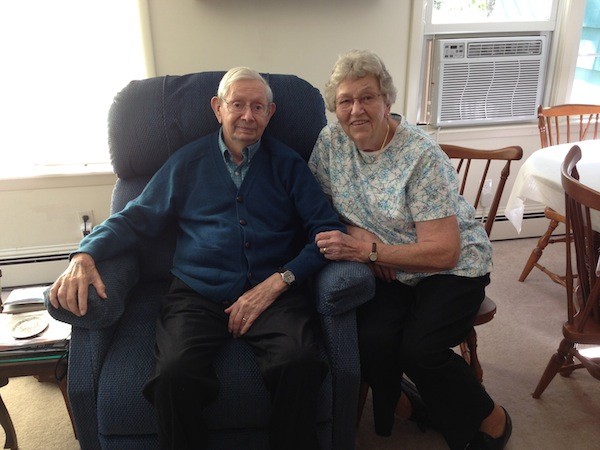
This summer, my 86-year-old neighbor Warren Gilman found out that he has Parkinson’s disease.
Parkinson’s disease is a disorder of the nervous system that affects how a person moves. The most common first sign of Parkinson’s is a tremor, but Warren’s hands are as steady as they ever were. His sharp-eyed wife Emma noticed some other worrisome signs, though.
Warren’s symptoms
- Sometimes he couldn’t get his right foot to move forward when he wanted to walk. It wouldn’t budge.
- All his movements seemed slower and rather stiff.
- His handwriting got smaller.
- He didn’t carry on conversations like he used to.
- His voice got softer.
- He began to have trouble remembering things.
Although they are all signs of Parkinson’s, Warren didn’t get diagnosed right away. He’s been dealing with some other medical issues the past few years. His doctor thought one of them was to blame for his trouble moving.
In 2012, he came down with eosinophilic pneumonia and was on prednisone for two years.
A year ago, he had a compression fracture in his lower back. He has no idea how it happened, but when you’re on prednisone for a long time, it can weaken your bones.
Because he’d had pneumonia, he couldn’t have surgery. Instead, he spent last winter doing physical therapy. He kept on having trouble walking. The doctor thought it was because of his back injury.
Emma wasn’t so sure. She knew something was wrong. After months of therapy, Warren just couldn’t seem to get his legs to work right. She began to suspect Parkinson’s.
One night in May, when he couldn’t walk from the living room into the kitchen, she called 911. The doctor still thought his fracture was causing the problem. But when she asked about Parkinson’s and listed all the things she was noticing, he listened.
Common early symptoms
Early signs and symptoms of Parkinson’s can vary from person to person and may be so mild they’re missed. The most common are:
- Trembling hand (when hand is relaxed)
- Slow movement
- Rigid muscles
- Stooped posture or balance problems
Symptoms get worse over time and others — like some of the ones Warren has — may develop. He saw a neurologist over the summer who confirmed that he had Parkinson’s. She ordered tests to rule out other conditions, listened to his medical history, and considered his symptoms. Emma says she was surprised it couldn’t be diagnosed with a blood test, but right now, there is none.
Treatment
People get Parkinson’s when their brain no longer produces enough dopamine, an important neurotransmitter. There’s no cure for it, but there are medications to relieve symptoms. Warren takes a combination of drugs called levodopa and carbidopa.
Levodopa converts into dopamine in the brain and carbidopa lessens its side effects of nausea and vomiting. It took awhile to get the right dose, but the drugs are working for Warren. For the first time in months, this past weekend he enjoyed a community bean hole supper and went to church the next morning.
Research shows that ongoing exercise may slow the progression of Parkinson’s disease. The Medically Oriented Gym in South Portland has a special Parkinson’s program, which I wrote about a few years ago. Warren has an appointment to see about joining the program. He’s had a rough few years, but now that he’s finally feeling better, he wants to make the most of it.
This post originally appeared on the Advantage Home Care blog, which I also write.

Leave A Comment